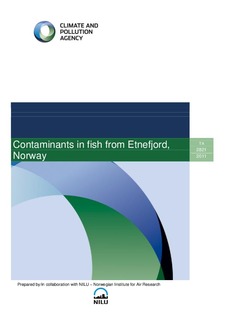Contaminants in fish from Etnefjord, Norway
Abstract
1,2,5,6,9,10-hexabromocyclododecane (HBCDD) is one of the most frequently used brominated flame retardants (BFR) and is considered as an emerging environmental pollutant. Recently, high levels of HBCDD were reported in five different fish species from Etnefjord, which is a branch of the Hardangerfjord at the southwest coast of Norway. This report raised some serious concerns and the Norwegian Climate and Pollution Agency (Klif) therefore initiated a survey of HBCDD in cod and flounder from Etnefjorden in order to confirm the findings. In addition to HBCDD, the levels of other environmental pollutants were analyzed in the fish, namely polybrominated diphenyl ethers (PBDEs), polychlorinated biphenyls (PCBs), hexachlorocyclohexane (HCH), dichlorodiphenyltrichloroethane (DDT), mercury (Mg), lead (Pb), cadmium (Cd) and arsenic (As). The fish muscle filet and livers were prepared and analyzed using recognized and previously published methods. The levels of HBCDD in the fish were low, representing expected background concentrations. HBCDD was only detected in the cod livers with concentrations ranging 0.3-5.7 ng/g wet weight, corresponding to 1.3-8.2 ng/g on a lipid weight basis. Previously, it was reported a level of 30 000 ng/g lipid weight in cod filet, which is, as far as we know, the highest HBCDD concentration ever reported in cod. Our study could, therefore, not confirm the recent findings that showed high HBCDD concentrations in fish from the Etnefjord area. Also, the levels of the other pollutants were low. For example, the concentrations of DDT, PCB, HCH and Hg can, according to Klifs system for classification of environmental state, be regarded as background levels (class 1, slightly/negligible polluted). In conclusion, there are no recons to believe that cod and flounder in Etnefjorden is exposed to considerable amount of environmental pollutants, neither of HBCDD nor other contaminants. Only further analysis of sediments from the inner site of the fjord can, however, positively reveal a possible HBCDD source. The Norwegian Climate and Pollution Agency. TA-2821/2011. Contaminants in fish from Etnefjord, Norway
Publisher
NILUSeries
NILU OR;50/2011TA-2821/2011
